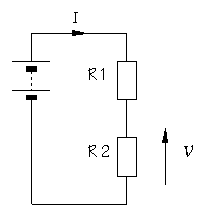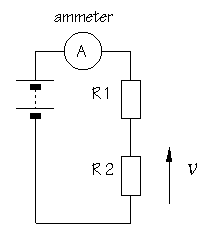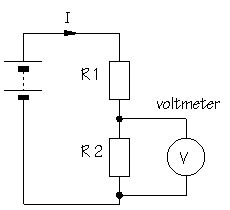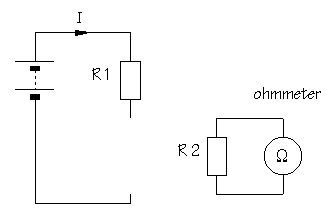|
|||||||||||||||||||||||||||||||||||||||
A |
 |
B |
 |
Let's think about the changes we would have to make to a practical circuit in order to include an ammeter.
To start with, we need to break the circuit so that the ammeter can be connected in series.
All the current flowing in the component at that point must pass through the ammeter.
Meters are not supposed to alter the behaviour of the circuit - or at least not significantly - it therefore follows that an ammeter must have a very LOW resistance - about the same resistance as a piece of connecting wire.
Using a Voltmeter
Diagram C shows the same circuit after connecting a voltmeter:
| A |  |
C |  |
Let's think about the changes we would have to make to a practical circuit in order to include a voltmeter.
This time, we do not need to break the circuit.
The voltmeter is connected in parallel across the component we are interested in - in between the two points of the circuit where the measurement is to be made.
As the voltmeter provides a parallel pathway, we have to be sure it pulls as little current as possible from the power source through that parallel strand. In other words, a voltmeter should have a very HIGH resistance.
Which measurement technique do you think is most useful to a circuit designer?
In electronic, voltage measurements are used much more often than current measurements.
The processing of electronic signals is usually thought of in voltage terms.
It is an added advantage that a voltage measurement is easier to make.
The orginal circuit does not need to be changed.
Often, the meter probes are connected simply by touching them to the points of interest - instead of connectors 'probes' are used - simply touching the bare metal at the correct points.
Using an Ohmmeter
An ohmmeter does not function with a circuit connected to a power supply.
If you want to measure the resistance of a particular component, you must take it out of the circuit altogether and test it separately, as shown in diagram D:
| A |  |
D |  |
So to measure the resistance of a component in a circuit we must first take it out of the circuit!
Ohmmeters work by passing a small current through the component and measuring the voltage produced.
If you try this with the component connected into a circuit with a power supply, the most likely result is that the meter will be damaged.
Most multimeters have a fuse to help protect against misuse, but take care!
 Much of the information and some of the images in this topic were taken from doctronics.co.uk - a brilliant, now defunct site that I used to direct my students towards. I have been unable to find out what happened to this site - but gladly I had saved some of the information for use in my lessons... and I now share them with you!
Much of the information and some of the images in this topic were taken from doctronics.co.uk - a brilliant, now defunct site that I used to direct my students towards. I have been unable to find out what happened to this site - but gladly I had saved some of the information for use in my lessons... and I now share them with you!
Follow me...


 sing a multimeter - revision of the use of the ammeter, voltmeter and ohmmeter
sing a multimeter - revision of the use of the ammeter, voltmeter and ohmmeter




